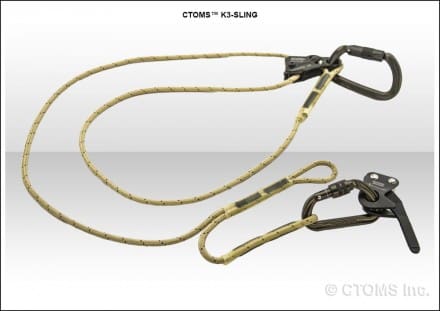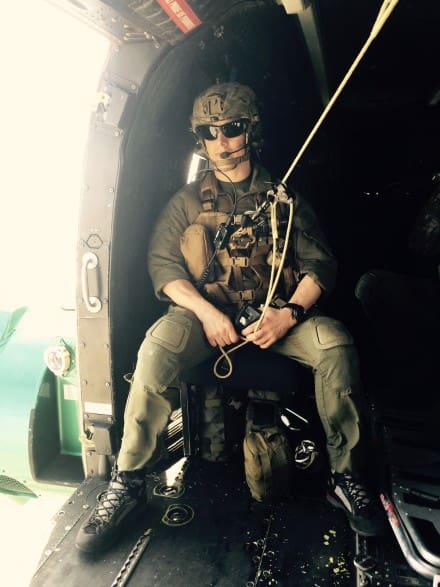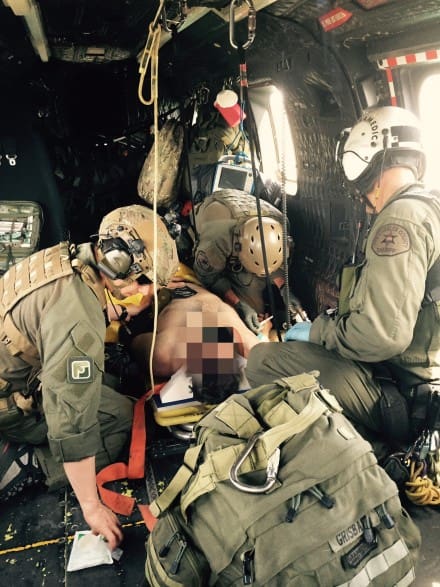K3 Tether
Sometimes the simple products are more complex than you think. Retention lanyards are an example. CTOMS performed testing on a typical helicopter retention lanyard (brand name withheld though many brands have very similar design and construction) – the type made of 1” tubular nylon with shock cord inserted into the core. The intent of the shock cord is to slightly shorten the tether to manage its length but provide stretch to a longer length for functional range.
100kg (225 lb.) test mass
Fall Factor 1.0: 10.2kN (2293 lbf)
Fall Factor 2.0: 13.2kN (2967.5 lbf) Failed
Traditional Tether from Chris Kopp on Vimeo.
At the same time CTOMS tested their K2-Sling adjustable retention lanyard. It is a basic design of 8mm accessory cord with sewn terminations, a connector at each end, and a 6mm sewn loop attached to the 8mm with a 4 wrap Prusik. That loop is then Cat’s Paw’d onto a quick release marine shackle. The design allows for tether length adjustment and also release from the system under load in a two part disconnect that prevent inadvertent release of a sole marine shackle attachment.
100kg (225 lb.) test mass
FF2.0: 13.5kN (3035 lbf) caught load
K2 Tether from Chris Kopp on Vimeo.
A high peak force, but at least still retained.
The next generation retention lanyard incorporates TRACE Systems force limiting technology. The new K3 Tether is made of 6mm TRACE Systems Rope and incorporates a Quickie Ascender (QA) for length adjustment. The long leg is 2 meters long, which means at maximum reach for most people, there will still be adequate slack to allow slippage through the device to arrest a fall. The K3 has been designed for both helicopter retention and mountaineering retention. It can be configured so that the adjustment (QA) is at the harness (usually helicopter) or at the anchor end (usually mountaineering).
The lanyard has a long leg and a short leg. The long leg is for personal retention and connection to an anchor, and when mountaineering, the short leg is to connect the rappel device to. The large loop would normally be girth hitched to the harness. When climbing with TRACE Systems, the short leg also is where the belay device would be connected providing a slight extension, which is ideal in that unique circumstance. A set of ettriers can also be hung on the tether carabiner and either as a single or a pair, is an excellent adjustable daisy chain for aid climbing.
In helicopter retention mode, the K3 would normally be flipped, connecting the adjustment end (QA) to your harness, and the “Y” end loop and short leg to a connector then to the aircraft. This ensures adjustment is always in reach.
The best part of the K3 is the soft catch of a major fall and slippage of rope through the device of under 1 meter. While the test videos are not in actual tether configuration, the adaptation is practically seamless.
100kg (225 lb.) test mass
FF2.0: 3.7kN caught load
QA Fall Factor 2 from Chris Kopp on Vimeo.
Drop tests on actual tethers are planned soon and once all is good and verified, the K3 will become commercially available.
High Angle Solutions is a weekly feature by DMM, CTOMS, and Atlas Devices.
Tags: CTOMS, High Angle Solutions





Hate to be that guy, anyone know that brand of boots are in the first picture? The black and tan color?
Hanwagg
Has to be AKU…